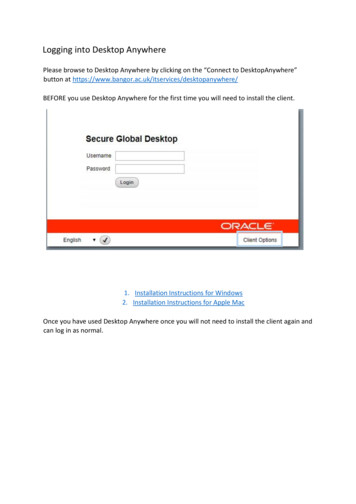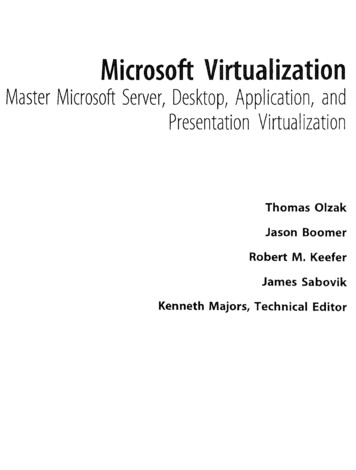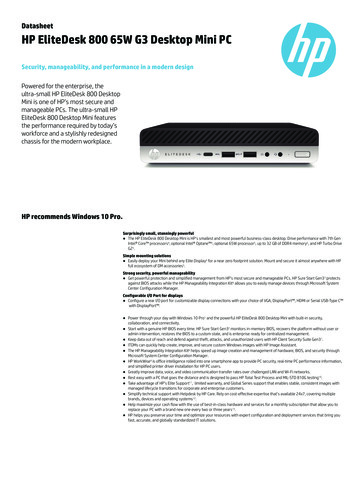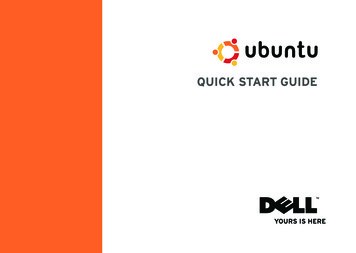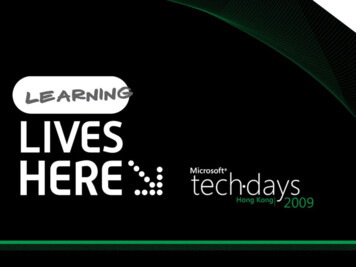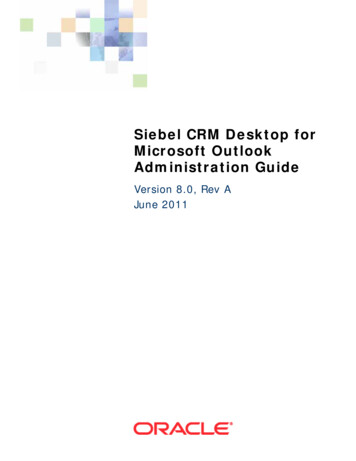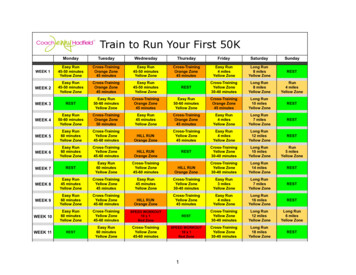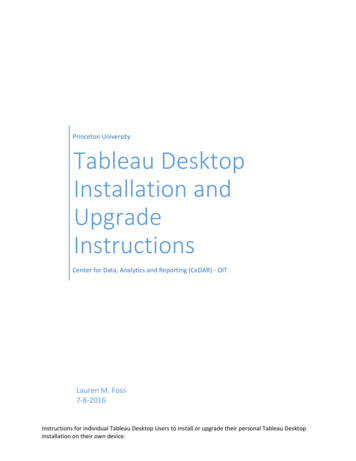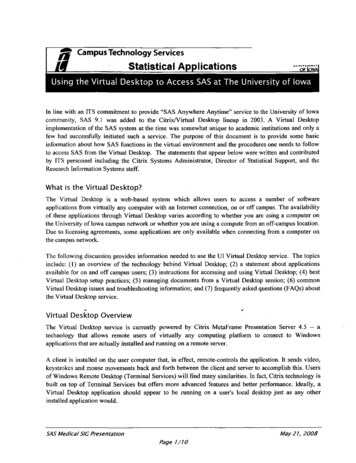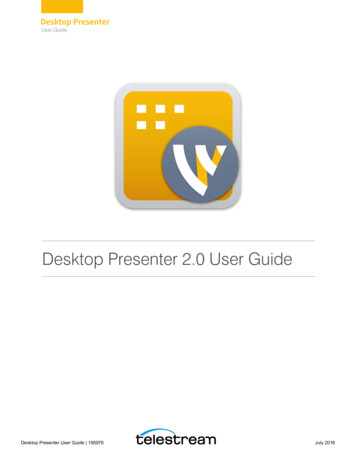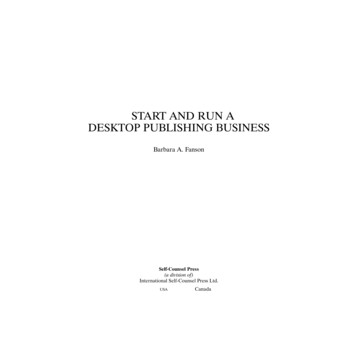
Transcription
Prelim.qxd8/10/20062:31 PMPage iiiSTART AND RUN ADESKTOP PUBLISHING BUSINESSBarbara A. FansonSelf-Counsel Press(a division of)International Self-Counsel Press Ltd.USACanada
TOC.qxd8/10/20062:31 PMPage viiCONTENTSINTRODUCTIONxi1WHAT IS A DESKTOP PUBLISHER?Who Needs Desktop Publishing?132THE MARKET AND OPPORTUNITIESWhat Is Success?Evaluate YourselfThe Marketing Plan: Developing a Market NicheThe Business Plan6677143MAKING YOUR BUSINESS LEGALNaming Your BusinessBusiness RegistrationSales Tax PermitsZoning By-LawsBusiness InsuranceStart-up Information161618202121214RAISING THE MONEYPersonal SavingsRelatives and FriendsBanksPersonal Financing OptionsPrivate InvestorsGovernment232424242526265PRICING YOUR WORKHow Much Does It Cost to Do Business?A Formula for Determining Your FeesMatching Your Previous WageSeven Ways to ChargeDon’t Start with a Low FeeVariable Fee ScaleMarkupBudgeted PricingWorking on SpecCharges for Typical Projects27272830313434343435366CHOOSING AND EQUIPPING YOUR OFFICEA Home Office3737vii
TOC.qxd8/10/20062:31 PMPage viiiRenting Office SpaceRent a MailboxFurnishing an OfficeEquipping an OfficeInternet AccessErgonomics in the OfficeComputer Software393940405051527MARKETING YOUR BUSINESSProspectingNetworkingAsk Existing Clients for LeadsStationeryPromotional LiteratureAdvertisingDirect MailIntroductory and Follow-up LettersPublic Relations ToolsWrite an Article for Other PublicationsUse the Internet to Promote Your BusinessE-mail Promotions555555575960616364646969708PROJECT PROCEDURESObtain Information about the ProjectPrepare an AgreementOpen a Job DocketEstablish a Production ScheduleContact SuppliersPrepare a QuotationDiscuss Fee, Schedule, and General Concepts with the ClientBegin Working on the ProjectSupervise Photo Shoot/Taping SessionComplete ArtworkProofreadGet Client ApprovalProduce MechanicalsProof Mechanicals and Get Client ApprovalDeliver Film and Proofs to PrinterDo a Press CheckDeliver Printed Material to the ClientInvoice the Client71727272727373737375757577777880808080viii Start & run a desktop publishing business
TOC.qxd8/10/20062:31 PMPage ixReview the ProjectFile The Project8383MANAGING YOUR BUSINESSTwenty-Five Hours of Unbillable Time per WeekBookkeepingTaxation and Your BusinessBusiness FormsCredit Card Merchant StatusCollection Tips For Accounts10210210310911111111110 WORKING EFFICIENTLYIncrease the Amount of Time You Spend on a ProjectLearn the Software ThoroughlyCreate Style SheetsCreate Headers and Footers in Microsoft WordCreate Master PagesClean up Client-Supplied Text FilesChange the Reader’s Spreads to Printer’s SpreadsEfficient Computer Files Output QuicklyKeep in StyleChange Color of Trim MarksWorking with Photo CDsProofreadOutput Two Files on One Larger Sheet of FilmGang Two Jobs Together for PrintingCommunicate with Your Print ShopUpdate Hardware and 12912912911 DEALING WITH SUPPLIERSDealing with Print ShopsDealing with Service BureausDealing with Contractors13013013513912 OPPORTUNITIES WITH THE INTERNETWhat is a Web Site?An Opportunity to Promote Your BusinessCreating Web PagesSetting up a Web SiteMaintain Your Web SitePromote Your Web SiteDesigning Web Pages for Clients1451461461461481491491509Contents ix
TOC.qxd8/10/20062:31 PMPage xHelping Clients Who Want to Create Their Own Web SitesPricing Web Page Design15015113 THE FUTURE OF DESKTOP PUBLISHINGCompeting with People from Different IndustriesChanging with the Industry152152153SAMPLES1 — Introductory Letter2 — Follow-up Letter3 — Confirmation Letter4 — Client Information Sheet5 — Production Order Form6 — Agreement of Terms and Conditions7 — Job Docket8 — Production Schedule9 — Printing Bid Request10 — Price Estimate11 — Quotation12 — Time Sheet13 — Project Summary14 — Style Sheet15 — Model Release16 — Cleaning up Electronic Files17 — Proofing Approval18 — Printing Instructions19 — Project Billing Worksheet20 — Invoice21 — Sales Journal22 — Cash Disbursements23 — Collecting Outstanding Accounts 4105113CHECKLISTS1 — Proofreading Checklist2 — Proof Checklist3 — Press Checklist4 — Service Bureau Checklist768182137WORKSHETS1 — Evaluate Yourself2 — Developing a Marketing Plan3 — Six-Month Budgetx Start & run a desktop publishing business81229
Chapter01.qxd8/10/20062:32 PMCHAPTERPage 11WHAT IS A DESKTOPPUBLISHER?No matter how great the author’s wisdom or how vital themessage or how remarkable the printer’s skill, unreadtype is merely a lot of paper and little ink. The trueeconomics of printing must be measured by how much isread and understood and not by how much is produced.— HERBERT SPENCERIn 1984, Paul Brainerd, of Aldus Corporation, coined the phrase“desktop publishing” to describe the artwork that could be createdusing Aldus’s page layout software program. Using a 300 dots perinch (dpi) laser printer hooked up to the computer, you could printout black-and-white, camera-ready artwork. A lot has changed sincethen. Today, you can take your file to a service bureau or commercial print shop to be output on paper, film, or color printout with upto 3,300 dpi. The quality has improved immensely.1
Chapter01.qxd8/10/20062:32 PMPage 2A desktop publisher is a person who uses a computer to produce artwork that can be printed. Desktop publishing is the processof publishing artwork from the top of a desk. Personal computerscan be used to produce publications, brochures, advertisements,business forms, sales literature, coupons, flyers, and much more.Desktop publishers should be prepared to design, typeset, and produce a variety of publications and sales literature, including:Publications Magazines Newsletters Newspapers Bulletins JournalsSales literature and promotional materials Brochures Booklets Flyers Coupons Direct mail materialsBusiness forms Invoices Contracts/agreements Purchase orders Project dockets Time sheetsBusiness stationery Letterhead Envelopes Business cards Mailing labelsInstructional materials Course manuals Course handouts Overhead transparencies2 Start & run a desktop publishing business
Chapter01.qxd8/10/20062:32 PMPage 3 Certificates Display cardsAs well, desktop publishers may be asked to produce othermaterials which are not really desktop publishing but may be produced by a computer. These include: Signage (interior and exterior) Point-of-purchase materials Packaging Electronic presentations Web page design Multimedia presentations Video editing AnimationSpecialize in an area that cannotbe performed by internal staff.Desktop publishing. Anyone can do it. But how many peoplecan meet promised deadlines, satisfy the client, and make money?Who Needs Desktop Publishing?Ten years ago, organizations hired outside vendors for three reasons:(a) To implement ideas that were conceived internally,such as mechanical art. But today, inexpensive computers and easy-to-use software allow companies to domuch of the production internally. For example, corporate newsletter editors used to write the stories and hirecompanies to typeset and paste-up the newsletter.Today, editors are writing and producing the entirenewsletter on a computer.(b) To handle overflow work and temporary projects.However, projects can now be completed much fasterbecause of computers, so there isn’t as much overflowwork available. There are more freelancers, so overflow work is harder to get, lower paying, and moredemanding.(c) To create projects that require special expertise, such ascorporate identity, color publications, package design,illustrations, presentations, multimedia, or speech writing. Today, talent, skills, and expertise may not exist inorganizations. The amount of high-level work that isfarmed out has increased. Organizations may not haveWhat is a desktop publisher? 3
Chapter01.qxd8/10/20062:32 PMPage 4enough internal staff to handle important assignmentssuch as signage, trade show exhibits, corporate marketing plans, or press releases, so they’ll hire freelancers tofill this void.Low-end creativity has virtually vanished, the middle segment(overflow work) is increasingly unproductive, but the high-end(special assignments) is flourishing. To have your own successfuldesktop publishing business, you need to specialize in an area thatcannot be performed by internal staff. Develop a market niche foryourself. For example, a corporate newsletter editor could produce a black-and-white newsletter, but could he or she createcolor newsletters and publications? This is just one area you couldspecialize in. How you can develop a market niche is discussed inmore detail in Chapter 2.The Self-Employed Desktop PublisherThe terms “freelancer” and “self-employed” refer to anyone whoworks for himself or herself, including independent contractors,small business owners, entrepreneurs, consultants, photographers,writers, designers, and desktop publishers. Successful self-employment is about discovering your uniqueness and spreading the word.As a desktop publisher, you can perform your service in a variety of ways. As a freelancer, you may work in other people’s officesand be paid hourly, daily, or per job. You might also choose to be atemp, working for a temporary personnel agency. When the agencycalls to see if you’re available for work, you can say yes or no.You could have a special deal or arrangement with a printer,public relations firm, advertising agency, or market researcher. Itcould provide office space in exchange for services, or printing inexchange for desktop publishing.With a sharing agreement, you could share an office or equipment with another desktop publisher or organization: one doessales while the other uses the equipment. This setup is similar to atime-sharing setup.If you know a lot about a certain subject, you could promoteyourself as a trainer or consultant, and turn your knowledge intomoney. Training and seminars have been very popular duringthe 1990s.If you can do something unique, you’re a specialist and canthrow out all the rules and establish your own fee.4 Start & run a desktop publishing business
Chapter01.qxd8/10/20062:32 PMPage 5There are also lots of opportunities for desktop publisherswho have a well-rounded knowledge of software and print production. Why not:(a) Start your own business.(b) Freelance for printers, advertising agencies, and in-houseart departments.(c) Work on a contract basis for printers, advertising agencies, and in-house art departments.(d) Work for a temporary placement agency.(e) Become a print broker obtaining assignments from various clients and sub-contracting the work to other desktop publishers.What is a desktop publisher? 5
DESKTOP PUBLISHING BUSINESS Barbara A. Fanson Self-Counsel Press (a division of) International Self-Counsel Press Ltd. USA Canada . The Business Plan 14 3 MAKING YOUR BUSINESS LEGAL 16 Naming Your Business 16 Business Registration 18 Sales Tax Permits 20 Zoning By-Laws 21
